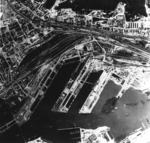Deutsche Werke Gotenhafen
| Type | 237 Shipyard | |
| Historical Name of Location | Gdynia, Pomorskie, Poland | |
| Coordinates | 54.539497000, 18.513314000 |
Contributor: Al Griffis
ww2dbaseIn the winter of 1920, the newly found Republic of Poland made the decision to develop the village at Gdynia into a major military and civilian dual-use seaport fully under Polish control (as opposed to the port at Danzig, which was a semi-autonomous city-state). By 1923 a 550-meter (1804-foot) pier, 175 meters (574 feet) of a wooden tide breaker, and a small harbor had been constructed. By the end of 1925, a 7-meter-deep harbor, the south pier, part of the north pier, and a railway were completed. The city itself began to build up in 1927. By the end of 1930, docks, piers, breakwaters, and many auxiliary and industrial installations were constructed or started. At the eve of the European War, Gdynia, with a population of over 120,000, was the largest seaport of the Baltic Sea, with 8,700,000 tons of goods passing through it, representing 46% of total Polish foreign trade. In the opening days of the European War, Gdynia was taken by German forces. In early 1940, the German military approached the shipbuilding firm Deutsche Werke based in Kiel, Germany to see if it would like to establish a ship repair facility in the port, now given the German name of Gotenhafen. Accepting the request, Deutschen Werke transformed the existing facilities into a major warship repair center. Gotenhafen also became a safe anchorage for large warships. Starting in 1943, the shipyard facilities were targeted by Allied bombings, but suffered relatively little damage. In 1944, Deutschen Werke began construction various submarine sections for XXI boats at Gotenhafen. In the final chapters of the war, as German troops fled westward, the seaport area was largely destroyed by the combination of German sabotage and Soviet bombardment. The German also sunk the damaged battlecruiser Gneisenau at the harbor entrance to deny Soviet use of the port. After the war, Gdynia returned to Polish rule, and the shipyard facilities continued to serve in their intended purpose.
ww2dbaseSource: Wikipedia
Last Major Update: Jul 2020
Deutsche Werke Gotenhafen Interactive Map
Photographs
 |  |
Maps
 |
Deutsche Werke Gotenhafen Timeline
| 23 Sep 1922 | Poland passed the Gdynia Seaport Construction Act. |
| 23 Apr 1923 | The ceremonial inauguration of the temporary military port of Gdynia, Poland was held. |
| 13 Aug 1923 | The first major seagoing ship arrived at Gdynia, Poland. |
| 12 Jul 1940 | Graf Zeppelin was towed to Gotenhafen (Gdynia), occupied Poland. |
| 3 Dec 1940 | German armed merchant cruiser Kormoran departed Gotenhafen (Gdynia), occupied Poland to raid Allied shipping, carrying supplies for 12 months, 280 naval mines, 40 land mines, and spare parts and torpedoes to supply submarines. |
| 17 Mar 1941 | Battleship Bismarck departed Kiel, Germany, arriving at Gotenhafen (Gdynia), occupied on the same day. |
| 18 May 1941 | After sundown, German battleship Bismarck and cruiser Prinz Eugen departed Gotenhafen (Gdynia), occupied Poland for the North Atlantic. The fleet was commanded by Admiral Günther Lütjens aboard Bismarck. |
| 19 May 1941 | Battleship Bismarck departed Gotenhafen (Gdynia), occupied Poland at 0200 hours and made rendezvous with heavy cruiser Prinz Eugen and destroyers Z-16 Friedrich Eckoldt and Z-23 off Rügen Island at 1200 hours. At 2230 hours, destroyer Z-10 Hans Lody joined the group. |
| 7 Nov 1941 | Emden arrived at Gotenhafen (Polish: Gdynia), occupied Poland and disembarked Grand Admiral Erich Raeder. |
| 4 Apr 1942 | Gneisenau arrived at Gotenhafen (Gdynia), occupied Poland. |
| 27 Aug 1942 | 9 British Lancaster bombers attacked Graf Zeppelin at Gotenhafen (Gdynia), occupied Poland with 5,550-pound bombs, causing no damage. |
| 26 Mar 1945 | Soviet forces captured Gotenhafen (Gdynia), occupied Poland, including the city's important shipyard and seaport facilities, although much of it were now damaged from sabotage and fighting. The harbor was now also blocked by a the sunken battlecruiser Gneisenau. |
Please consider supporting us on Patreon. Even $1 per month will go a long way! Thank you. Please help us spread the word: Stay updated with WW2DB: |
Visitor Submitted Comments
All visitor submitted comments are opinions of those making the submissions and do not reflect views of WW2DB.

Gdynia, Pomorskie, Poland
Latitude-Longitude:
54.5395, 18.5133
- » 1,182 biographies
- » 337 events
- » 45,132 timeline entries
- » 1,249 ships
- » 350 aircraft models
- » 207 vehicle models
- » 376 weapon models
- » 123 historical documents
- » 261 facilities
- » 470 book reviews
- » 28,430 photos
- » 365 maps
Winston Churchill
21 Jun 2025 11:29:53 PM
Working on a shipyard manifest I presume?